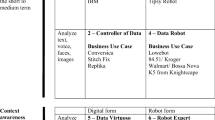Abstract
Our society is in the middle of the AI revolution. We discuss several applications of AI, in particular medical causality, where deep-learning neural networks screen through big data bases, extracting associations between a patient’s condition and possible causes. While beneficial in medicine, several questionable AI trading strategies have emerged in finance. Though advantages in many aspects of our lives, serious threats of AI exist. We suggest several regulatory measures to reduce these threats. We further discuss whether ‘full AI robots’ should be programmed with a virtual consciousness and conscience. While this would reduce AI threats via motivational control, other threats such as the desire for AI—human socioeconomic equality could prove detrimental.



Similar content being viewed by others
Notes
Esteva et al. (2017).
Bhattacharya et al. (2017).
The difference between an Android and a Humanoid is simply that an Android is made to look as human as possible, whereas a Humanoid does not necessarily mimic human forms and features. In contrast to an Android and a Humanoid, a Cyborg (short for cybernetic organism) is a being with organic and mechanical parts, popularized by the fictional character Terminator.
Morton and Kissell (2013).
The term Front Running comes from the days when brokerages received phone orders from their clients. A ‘runner’ would bring the order to the trading pit to be executed. Sometimes another trader would ‘front run’ the runner to place an order on his own account first.
A dark pool is an electronic trading system, in which the dealer, the type of order, and the order size is not known to other dealers to provide anonymity.
Tetlock et al. (2008).
Singularity has many different meanings in different sciences, sometimes even different meanings in the same science. In math singularity can refer to a function that is not ‘well-behaved’, i.e. not differentiable or is infinite. In Astrophysics it can refer the state of infinite density and heat just before the Big Bang, or the gravity induced singularity in Black Holes.
For a plethora of consciousness definitions, in fact 23, from Aristotle to modern definitions, see Pagel and Kirshtein (2017).
McDermott (2007).
Sir Diaper is the nickname that Siri is calling me, my kids apparently having access to my iPhone.
References
Asimov I (1950) “Runaround”, The Isaac Asimov Collection ed., New York City
Bhattacharya A, Young A, Wong A, Stalling S, Wei M, Hadle D (2017) Precision diagnosis of melanoma and other skin lesions from digital images. AMIA Jt Summits Transl Sci Proc
Cox MT (2005) Metacognition in computation: a selected research review. Artif Intell 169(2):104–141
Descartes R (1628) Rules for the direction of the mind
Esteva A, Kuprel B, Novoa R, Ko J, Swetter S, Blau H, Thrun S (2017) Dermatologist-level classification of skin cancer with deep neural networks. Nature 542:115–118
Gallup G Jr (1970) Chimpanzees: self recognition. Science 167:86–87
Glantz M, Kissell R (2013) Multi-asset risk modeling: techniques for a global economy in an electronic and algorithmic trading era. Academic Press, Cambridge
Koch C, Tononi G (2008) Can machines be conscious? IEEE Spectrum, vol 45. IEEE, pp 55–59
Leibnitz G (2011) 1714, “Monadology”; George MacDonald Ross (trans.), archived from the original on July 3
McDermott D (2007) Artificial intelligence and consciousness. Yale University, New Haven
Morton G, Kissell R (2013) Multi-asset risk modeling: techniques for a global economy in an electronic and algorithmic trading era. Academic Press, Cambridge
Pagel JF, Kirshtein P (2017) Machine dreaming and consciousness. Academic Press, Cambridge
Reggia JA (2013) The rise of machine consciousness: studying consciousness with computational models. Neural Netw 44:112–131
Schumpeter J (1975) Capitalism, socialism and democracy. Harper 1975, [orig. pub. 1942]
Searle JR (1980) Minds, brains, and programs. Behav Brain Sci 3(3):417–424
Tarleton N (2010) Coherent extrapolated volition: a meta-level approach to machine ethics. The Singularity Institute, San Francisco
Tetlock PC, Maytal S-T, Macskassy SA (2008) More than words: quantifying language to measure firms’ fundamentals. J Fin 63(3):1437–1467
Yudkowski E (2004) Coherent extrapolated volition. Machine Intelligence Research Institute
Author information
Authors and Affiliations
Corresponding author
Additional information
Publisher’s Note
Springer Nature remains neutral with regard to jurisdictional claims in published maps and institutional affiliations.
Rights and permissions
About this article
Cite this article
Meissner, G. Artificial intelligence: consciousness and conscience. AI & Soc 35, 225–235 (2020). https://doi.org/10.1007/s00146-019-00880-4
Received:
Accepted:
Published:
Issue Date:
DOI: https://doi.org/10.1007/s00146-019-00880-4




